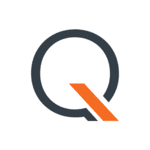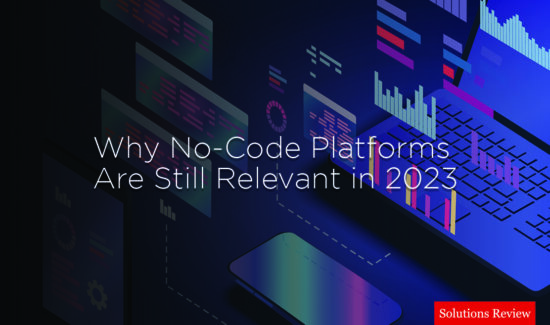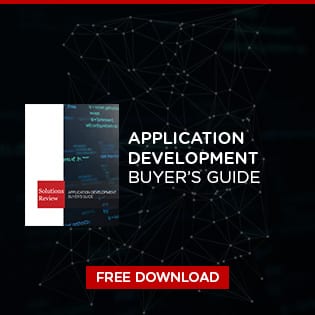Solutions Review Names 4 Application Development Vendors to Watch, 2020


Solutions Review’s Application Development Vendors to Watch is an annual listing of solution providers we believe are worth monitoring. Companies are commonly included if they demonstrate a product roadmap aligning with our meta-analysis of the marketplace. Other criteria include recent and significant funding, talent acquisition, a disruptive or innovative new technology or product, or inclusion in a major analyst publication.
Who are the top Application Development Vendors to Watch in 2020?
As we enter the new decade, the editors here at Solutions Review are focusing on what lies ahead. The marketplace for application development platforms is maturing everyday, getting more and more crowded with software tools for a variety of use cases, verticals, deployment methods, and budgets.
Application development can sometimes be viewed as a difficult field to enter, as it requires complex technical knowledge to develop something new. But with the rise of low code and no code application development platforms, custom business apps are no longer out of reach for companies without programming knowledge. Many vendors also offer full developmental services, or will “rent” out their employees to companies that need them. If your business has been waiting for the chance to develop custom enterprise app, don’t wait any longer.
In that spirit, we’ve turned our gaze to the future of application development software and platforms. Whether it’s inclusion in a recent analyst report, the release of an innovative tool, or a bump in venture funding, these are the application development vendors that have earned watch list status from Solutions Review for the year ahead.
Note: Companies are listed in alphabetical order.
Appian
 Appian’s unique low code development platform combines business process management, artificial intelligence, and robotic process automation. Without writing any code, users can integrate databases, systems, file servers, data buckets, external web services, and any other applications they need. Appian was named a Leader in the 2019 Forrester Low-Code Development Platforms report, and has been used by brands like Sprint, Barclays, and Enterprise. Appian was also featured as a Leader in the 2019 Gartner Magic Quadrant for Enterprise Low-Code Application Platforms, and a Visionary in the 2019 Gartner Magic Quadrant for Multiexperience Development Platforms.
Appian’s unique low code development platform combines business process management, artificial intelligence, and robotic process automation. Without writing any code, users can integrate databases, systems, file servers, data buckets, external web services, and any other applications they need. Appian was named a Leader in the 2019 Forrester Low-Code Development Platforms report, and has been used by brands like Sprint, Barclays, and Enterprise. Appian was also featured as a Leader in the 2019 Gartner Magic Quadrant for Enterprise Low-Code Application Platforms, and a Visionary in the 2019 Gartner Magic Quadrant for Multiexperience Development Platforms.
Kony
 Kony Quantum is combines the accessibility of low-code development with a comprehensive set of backend services and integration capabilities. Quantum supports the development of both web apps and native apps, and provides high quality UX, intelligent chatbots, and conversational apps. Quantum makes it easy to integrate with data, create new services, orchestrate and transform data, and configure backend business processes. Last year, Kony released its Conversational AI DevKit; it was also also featured as a Challenger in the 2019 Gartner Magic Quadrant for Enterprise Low-Code Application Platforms, and a Leader in the 2019 Gartner Magic Quadrant for Multiexperience Development Platforms.
Kony Quantum is combines the accessibility of low-code development with a comprehensive set of backend services and integration capabilities. Quantum supports the development of both web apps and native apps, and provides high quality UX, intelligent chatbots, and conversational apps. Quantum makes it easy to integrate with data, create new services, orchestrate and transform data, and configure backend business processes. Last year, Kony released its Conversational AI DevKit; it was also also featured as a Challenger in the 2019 Gartner Magic Quadrant for Enterprise Low-Code Application Platforms, and a Leader in the 2019 Gartner Magic Quadrant for Multiexperience Development Platforms.
Mendix
 Mendix’s low code development platform focuses on the visual development of full-stack applications using an approachable and friendly language. Users can create apps with no-code, low-code, or custom code extensions, and Mendix allows for simultaneous development with multiple people in real time. AI-assisted development guides new users, automates certain tasks, and prevents defects and mistakes. Recently Mendix supplied Rabobank with its low-code platform to build a new online-only banking portal; it was also featured as a Leader in the 2019 Gartner Magic Quadrant for Enterprise Low-Code Application Platforms, and a Leader in the 2019 Gartner Magic Quadrant for Multiexperience Development Platforms.
Mendix’s low code development platform focuses on the visual development of full-stack applications using an approachable and friendly language. Users can create apps with no-code, low-code, or custom code extensions, and Mendix allows for simultaneous development with multiple people in real time. AI-assisted development guides new users, automates certain tasks, and prevents defects and mistakes. Recently Mendix supplied Rabobank with its low-code platform to build a new online-only banking portal; it was also featured as a Leader in the 2019 Gartner Magic Quadrant for Enterprise Low-Code Application Platforms, and a Leader in the 2019 Gartner Magic Quadrant for Multiexperience Development Platforms.
OutSystems
 OutSystems is a widely used development platform that allows its users to quickly create mobile apps with a wide variety of tools at their disposal. Users create their applications in a visual environment, where they can define data models, business logic, workflow processes, and UI for both web applications and mobile devices. Visual code can be extended through additional software development using a variety of languages including JavaScript, HTML, CSS, and C#. In 2019, OutSystems released AI-assisted development capabilities, as well as features to help support and speed up citizen development.
OutSystems is a widely used development platform that allows its users to quickly create mobile apps with a wide variety of tools at their disposal. Users create their applications in a visual environment, where they can define data models, business logic, workflow processes, and UI for both web applications and mobile devices. Visual code can be extended through additional software development using a variety of languages including JavaScript, HTML, CSS, and C#. In 2019, OutSystems released AI-assisted development capabilities, as well as features to help support and speed up citizen development.
Low-code platforms are a potential alternative to native software development using tech stacks such as React or Node. Software developers often require hiring React developers if building front-ends or Node.js developers for the back-end. Low-code platforms put the power of development in the hands of non-technical visionaries inside organizations to help them build tools and products that are valuable.
- The 6 Best Application Development Podcasts You Should Be Listening To - February 21, 2020
- The 4 Best Application Development TED Talks for Practitioners - February 19, 2020
- The Best Application Development Events and Conferences to Attend in 2020 - February 13, 2020






















